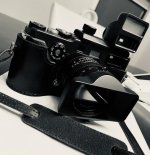OlivierAOP
medium format
ok...
thinking of this: is there a way of altering a regular 120 bronica etrs back to advance only half the regular distance?
If so, by cutting a slot in a dark slide, there could be a way to get 30 panos from a 120 film.
I remembered this post after I read something about that today. Here's what can be done.
Modify the dark slide by removing almost half of it, offsetting the cut by 2-3 mm. Also remove the tab that locks the shutter when inserted.
Insert the slide, and you can expose the top half of the regular frame.
Reverse the slide, toggle the multi-exposure switch, cock the shutter and frame the bottom half.
You'd get 30 or 24 frames: ~19x56mm on 645, ~25x56mm on 6x6.
Edit. Here's another way. You mask the film back, leaving the central half (minus small offset for spacing) exposed. Toggle the multi-exposure switch and advance half a frame via the winding knob on the film back. Eyeball the half-way point between the marked frame numbers. This way you can mask the screen for framing. And you can maybe get 2-3 extra frames by offsetting the start arrow and by using a 220 back.
Last edited:













